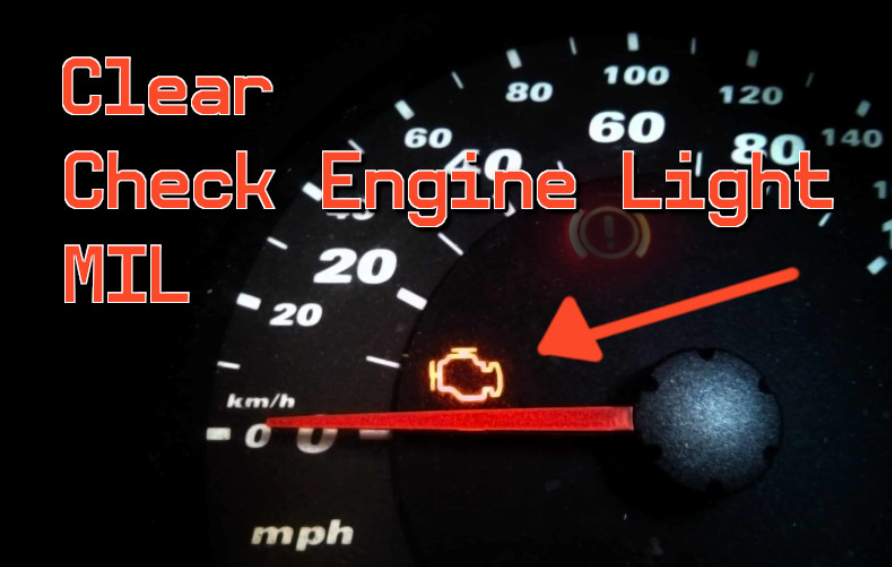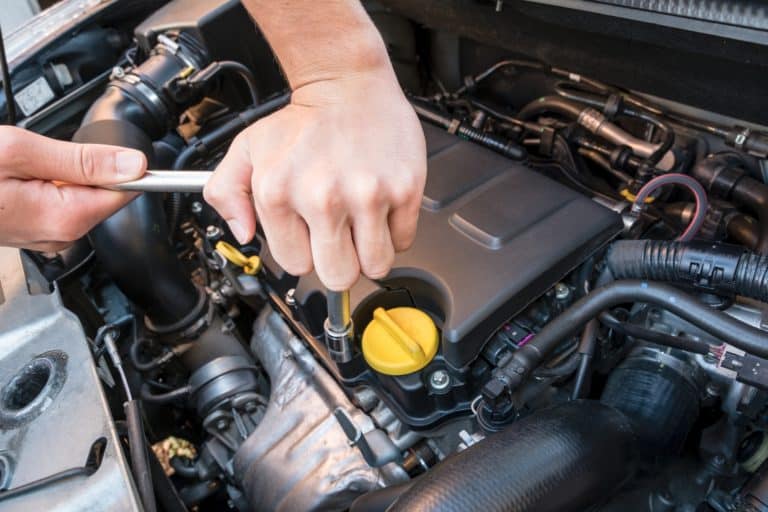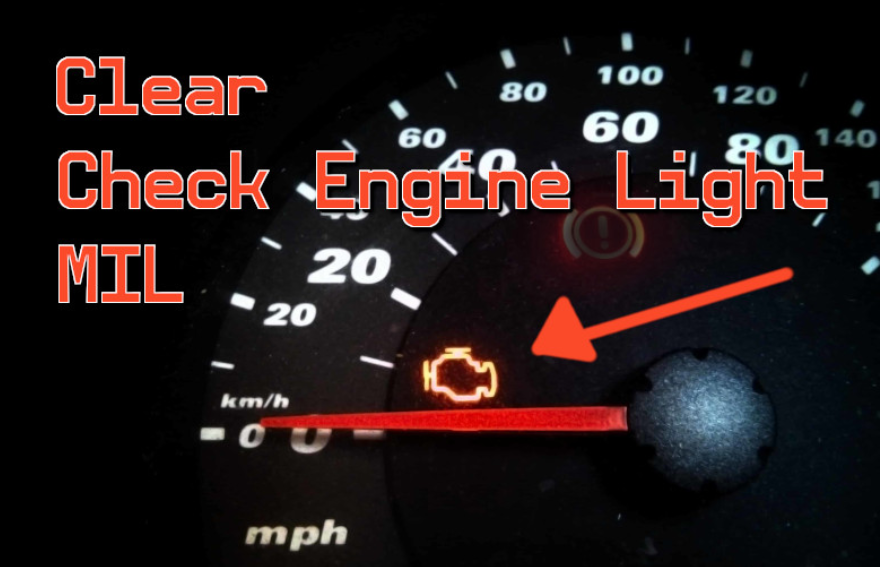Is your Check Engine Light (MIL) on and you need to clear it?
 The answer on how to clear OBD2 codes without a scanner is easy. In fact, you can do it in a couple of steps. But before we get to that, it is important to discuss the reasons for doing so.
The answer on how to clear OBD2 codes without a scanner is easy. In fact, you can do it in a couple of steps. But before we get to that, it is important to discuss the reasons for doing so.
The check engine light could mean many things. For all intents and purposes, the malfunction indicator light or MIL could also mean problems with the anti-lock brakes (ABS), airbags (SRS), or the automatic transmission. If you have an older car, the check engine light could be as simple as a leaking gas cap or as complicated as an emissions or transmission problem.
I know it’s annoying to drive with an illuminated check engine light which is probably why you’re reading this and wondering how you can remove that pesky light.
Yes, you can clear the codes without using a scanner.
However, if the source of the problem is not fixed right away, clearing or resetting the check engine light is not the right solution. In fact, the check engine light will turn back on in a matter of seconds if the problem still persists.
Before clearing the light find the problem
Okay before we get on the clearing the check engine light without a scanner I want to let you know that you should not just clear it without finding the cause of the problem. Listen, that light is on to tell you that there is a, maybe major or maybe minor, issue with your vehicle engine (or braking or airbags).
So if you just clear that MIL without finding and fixing the root cause, it’s like stepping on a nail and not getting a tetanus shot… Sure you’ll probably be all right, but there’s a chance you could get really sick and die.
Same with your car, maybe the light’s on because the gas cap is loose, or maybe you’ve got a high temp in your transmission and it’s about to go out.
What I highly recommend you do before moving on and clearing the code is buy an OBD2 Scanner – they’re very affordable, easy to use, and will tell you if the issue is something to get concerned about. We wrote a ton of reviews on our site, but here’s three of the top scanners.
How to Reset or Clear OBD2 Codes without a Scan Tool
Okay, let’s get straight to the steps on how to reset trouble codes without using a scanner and then we’ll chat about it.
1. Park the car in a safe and level area. Engage the parking brake and pop open the hood.
2. Remove the negative (-) black cable from the battery. Use a simple wrench to loosen the clamps on the battery terminals.
3. Remove the positive (+) red cable from the battery. Under no circumstances should you allow the negative and positive cable from touching each other as you do this.
4. After removing the battery cables, you should proceed to cycle the ignition switch to the ON and OFF position for 3 to 5 times.
5. Press on the horn button in the steering wheel. Keep it pressed for 30 seconds to a full minute to drain out all the stored power in the ECU capacitor. The horn is connected to a hot circuit. This is the reason why the horn can be engaged regardless of the key position in the ignition. You are essentially draining out all the electrical power in the ECU by pressing on the horn while the battery is disconnected.
6. This step is optional, but I would advise you to wait for another 10 to 15 minutes before reconnecting the battery.
7. Reconnect the battery cable to the car battery. Start with the red positive terminal followed by the black negative terminal. Make sure to tighten the clamps sufficiently.
8. Turn the ignition ON and check for the warning lights on the console. Start the engine and allow the engine to warm up. By this time, the check engine light should be OFF.
A Word To The Wise
Back in the days of OBD1, clearing the codes is as simple as removing the terminals from the battery. The entire process took a few minutes.

But with OBD2, it’s not as simple. The vehicle ECU basically governs every electronic gadget in the vehicle. This includes the theft deterrent radio system, the factory alarm, and other accessories. Disconnecting the power in an OBD2-compliant vehicle (basically any car manufactured after 1996) might do some funny things like resetting the radio settings, power seats, the clock, and memory settings. It will also reset or clear the stored memory settings for idle control and the transmission shift points.
On some modern vehicles, there’s a built-in SLEEP mode. This basically enables the vehicle to disable the alarm system or store the learned memory in a separate module. This allows the ECU to revert back to the old settings after disconnecting and reconnecting the battery. Again, check your owner’s manual if your car has this feature.
But simply disconnecting the battery will not get rid of OBD2 fault codes. The ECU will still be able to store the trouble codes using power from a capacitor. In order to reset the codes, the built-in capacitor in the ECU will need to be drained of power as well.
It’s similar to draining the power on a laptop or CPU. The idea is to depress the power button for at least 30 seconds to drain all the stored power in the laptop ECU. But instead of pressing the power button (since your car doesn’t have a power button), you’ll need to drain the ECU capacitor using a simple method.
What to Expect After Disconnecting the Battery
Like I mentioned earlier, the check engine light will turn back ON again if the source of the OBD2 code is not fixed. Hopefully this is not the case.
But after disconnecting the battery and draining the capacitor in the ECU, your vehicle might act weird momentarily. You may notice some idling problems or rough idling as the computer adjusts itself to find the proper settings.
Don’t panic. This is all normal. If your car is equipped with an automatic transmission, the vehicle might shift awkwardly as well. This is all part of a self-check feature that the ECU performs after starting the car. All the settings will eventually be recovered and the idling or shift problems will eventually go away.
This is the reason why the vehicle will need to be driven normally after reconnecting the battery. This is what mechanics call the normal drive cycle. The emissions computer in the OBD2 system must be able to complete at least one drive cycle to restore the right settings.
If all goes well, the check engine light should remain OFF for the remainder of your drive. But if the check engine light returns, you have no choice to plug in a scan tool to determine the cause of the fault.
Conclusion
At the first sign of a check engine light, the first important step is DO NOT PANIC! In most cases, the vehicle is still drivable despite the presence of a trouble code. If you don’t have a can tool, I highly recommend not to perform the steps above on how to clear OBD2 codes without using a scanner.
Instead, the wiser thing to do is to proceed directly to the dealership or favorite garage and let the experts do their thing. If you clear the codes yourself without determining the source of the trouble code, you will only be wasting your time and patience.
The good news is you can essentially buy your very own OBD2 scan tool for around $20. Wireless OBD2 scanners are ideal and can pair easily with your smartphone or tablet via Bluetooth or Wi-Fi. Take the guesswork off and get yourself a reliable OBD2 scanner. It is one of the best things you can do for your precious ride!
